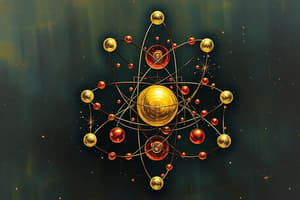Podcast
Questions and Answers
What are the main parts of an atom?
What are the main parts of an atom?
- Neutrons (correct)
- Nucleus (correct)
- Protons (correct)
- Electrons (correct)
What is the mass of a proton?
What is the mass of a proton?
1 dalton (da) or approximately 1.7 x 10^-24 grams
Electrons have a significant mass compared to protons and neutrons.
Electrons have a significant mass compared to protons and neutrons.
False (B)
What defines elements and their properties?
What defines elements and their properties?
What does the Bohr model represent?
What does the Bohr model represent?
Which six elements make up 98% of the mass of living organisms?
Which six elements make up 98% of the mass of living organisms?
What is the atomic number?
What is the atomic number?
Match the isotopes of hydrogen with their descriptions:
Match the isotopes of hydrogen with their descriptions:
What is atomic weight?
What is atomic weight?
Radioisotopes are stable and do not give off any radiation.
Radioisotopes are stable and do not give off any radiation.
What determines how an atom combines with other atoms?
What determines how an atom combines with other atoms?
What happens during atomic reactions?
What happens during atomic reactions?
Flashcards are hidden until you start studying
Study Notes
Parts of the Atom
- Nucleus: dense, positively charged core
- Electrons: negatively charged particles (-1) orbiting the nucleus
- Protons: positively charged particles (+1) located within the nucleus
- Neutrons: neutral particles within the nucleus, may be present or absent
- Atoms are electrically neutral with equal numbers of protons and electrons
Mass
- Mass measures the quantity of matter; a proton's mass serves as a standard unit called dalton or atomic mass unit (amu)
- Proton or neutron mass: 1 dalton (1.7 x 10^-24 grams); electron mass: negligible (9 x 10^-28 grams)
Electrons' Contribution
- Electrons have negligible mass but are crucial in forming stable atomic associations
Elements and Properties
- Elements are pure substances with one type of atom characterized by unique mass and interaction properties
Bohr Model
- Visual representation of the helium atom illustrating electron paths around the nucleus
Abundance of Elements
- 98% of the mass of living organisms is made up of six elements: carbon, hydrogen, nitrogen, oxygen, phosphorus, and sulfur
Importance of Specific Elements
- Sodium and potassium: essential for nerve function
- Calcium: serves as a biological signal
- Iodine: component of vital hormones
- Magnesium: bound to chlorophyll in plants
Atomic Notation
- Atomic number: unique count of protons in an atom's nucleus, defining each element
- Mass number: total number of neutrons and protons in an atom's nucleus; hydrogen typically has one neutron
Isotopes
- Isotopes of the same element differ in neutron count but share the same proton number
- Most isotopes are stable
Hydrogen Isotopes
- Hydrogen-1: 1 proton, 0 neutrons
- Deuterium: 1 proton, 1 neutron
- Tritium: 1 proton, 2 neutrons
Carbon Isotopes
- Carbon-12: 6 protons, 6 neutrons
- Carbon-13: 6 protons, 7 neutrons
- Carbon-14: 6 protons, 8 neutrons
Atomic Weight
- Average of mass numbers of naturally occurring isotopes of an element
- Example: Carbon has an atomic weight of 12.011
Radioisotopes and Uses
- Unstable isotopes that emit radiation (alpha, beta, gamma) from the nucleus
- Released energy can change the number of protons, transforming the element
- Applications include labeling molecules, dating fossils, and medical uses (e.g., Cobalt-16 for cancer treatment)
Electrons Functions and Locations
- Electrons dictate atomic behavior and reactivity through chemical reactions
- Location is defined by orbitals, where electrons are found 90% of the time
Orbitals and Shells
- Electrons arranged in shells, each with specific shapes and orientations
- Maximum of 2 electrons per orbital; energy level increases with distance from the nucleus
- First shell has one s orbital; second shell accommodates up to 8 electrons through 4 orbitals (1 s and 3 p orbitals)
Effect of Electron Position
- Filling occurs from lowest to highest energy levels, with stability achieved when outermost shells have eight electrons (valence shell)
- Unpaired electrons in the outer shell indicate potential reactivity of the atom
Examples of Stable Electrons
- Atoms like helium, neon, and argon possess full outer electron shells ensuring chemical stability
Atomic Reactions
- Atoms attain stability through sharing, gaining, or losing electrons, leading to stable bonds with other atoms
Studying That Suits You
Use AI to generate personalized quizzes and flashcards to suit your learning preferences.




